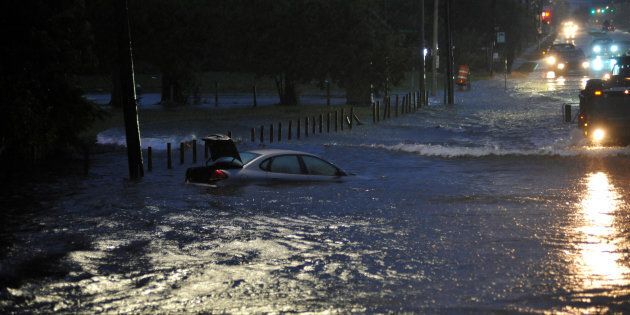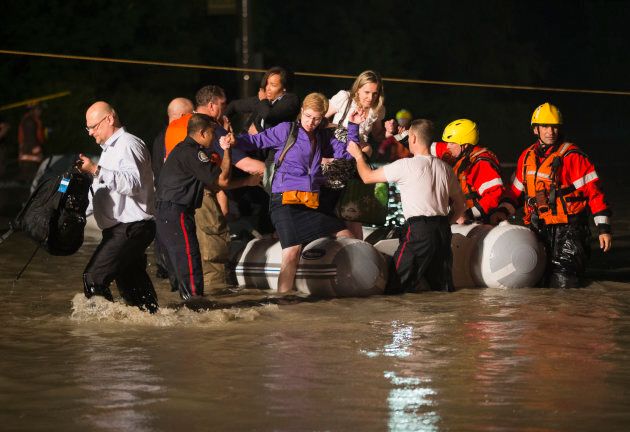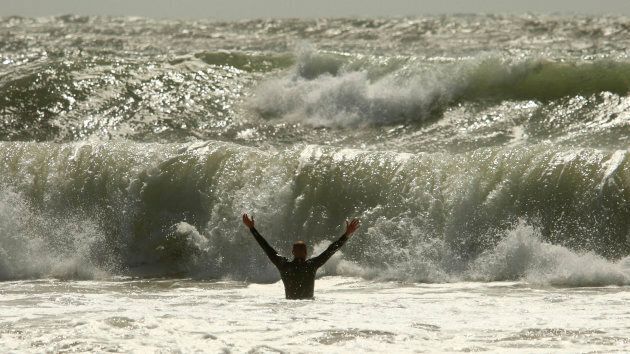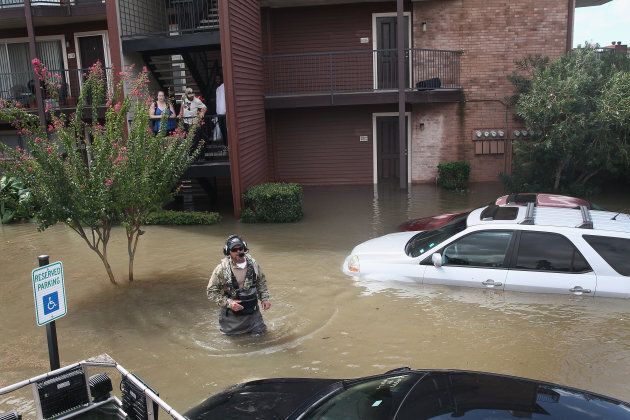
With Hurricane Harvey's extreme flooding causing devastation in Texas, one meteorologist wanted to visualize the massive volume of water from the hurricane, and how it would affect Canadian cities.
The results are eye-opening.
Metropolitan Toronto, for one, would be pretty much submerged if it received a massive downpour, all at once, of rainfall akin to Harvey.
To create this hypothetical model, Scott Sutherland of the Weather Network took the total rainfall that fell on all of Texas from Harvey, from the start of the storm to last Monday (the time when his post was published).
According to the estimate he used from Mashable, 15 trillion litres, or 56.8 cubic kilometres, had fallen on the state during that time.
He then divided 56.8 cubic kilometres by the square kilometre area of Metro Toronto (630.2 sq km). That resulted in a depth of 90 metres, or roughly 27 building stories.
Then he mapped the scenario with the help of Google Maps to give readers an idea of what that would look like:
But don't be alarmed, because it's purely hypothetical, Sutherland says. It's not meant to be realistic.
"Hurricanes don't drop all of their water at once, and they don't drop a state's worth of water onto one city," he told HuffPost Canada in an email. "Plus, there would have to be a wall, 90 metres tall ... completely closing off the city, so that the water couldn't drain off.
"The image is just a data visualization, to let us see what 56.8 cubic kilometres of water looks like, in a way that means something to our daily lives," he said.
It is a massive volume of water to get one's head around, especially when rainfall is measured in millimetres. Global News also did a visualization, in which it calculated the storm's impact using a larger square area of the GTA and a different total amount of rainfall, 79 trillion litres.
The city didn't make out much better in Global's scenario — it would still be submerged under 50 metres of water.
And Toronto is not good with flooding a fraction of that size.

In July 2013, Toronto's Pearson International Airport received 126 mm of rain in a three-hour period during thunderstorms, according to The Weather Network. The subsequent flooding shut down the downtown core.
An owner of a Ferrari was notably forced to abandon his luxury ride after it was submerged in a downtown Toronto underpass. The city suffered power outages, public transit was stopped and people were stranded. The storm broke records.
Eighty per cent of Mississauga lost power. Stranded commuters on GO Transit had to be rescued with small inflatable boats.

During the July flood, Toronto received around a seventh of its average yearly rainfall in three hours.
The total amount of rain that fell in Houston in the past week is estimated to be nearly double Toronto's annual average.
Hurricanes lose power as they reach Canada
But there's not a whole lot to be afraid of, at least not for most Canadians.
By the time most hurricanes reach Canada, they're much less powerful than they started out being.
Even these storm remnants can be strong, but the type of devastation that is raining down on Texas is unlikely, according to Global News.
Atlantic Canada is at biggest risk. Nova Scotia, for example, gets a hurricane every three years on average.

The waters around Canada are also too cold to support a hurricane stronger than Category 3. For reference, Hurricane Harvey was a Category 4 at its strongest. Katrina was a Category 5.
While Harvey's impact on Canada is limited, meteorologists are already keeping an eye on the next potential storm, Hurricane Irma.
"The bigger worst-case scenario is the development of the next storm. That's the one that right now, we really want to pay attention to,'' said Halifax meteorologist Jim Murtha, who works out of the Canadian Hurricane Centre in Dartmouth.
Murtha said the storm could develop over the weekend off the east coast of Florida.

He said the system has the potential to be "quite a storm" and could bring heavy rainfall and strong winds to parts of Atlantic Canada mid-next week or beyond.
"It's a little bit of a domino effect. What happens to Harvey and how long it lingers along the Gulf Coast, and what happens to the remnants of that... will have an effect on the evolution of this second system off the coast of Florida,'' he said.
Murtha said the centre is hoping forecasts become clearer over the weekend.
With files from the Canadian Press and Lisa Yeung.
CLARIFICATION: Sept. 3, 2017 - This post has been updated to include additional detail from Scott Sutherland on the mathematical model he used to calculate the depth to which Toronto would be submerged if it had been subject to the 15 trillion litres of water that fell on Texas during a portion of Hurricane Harvey.